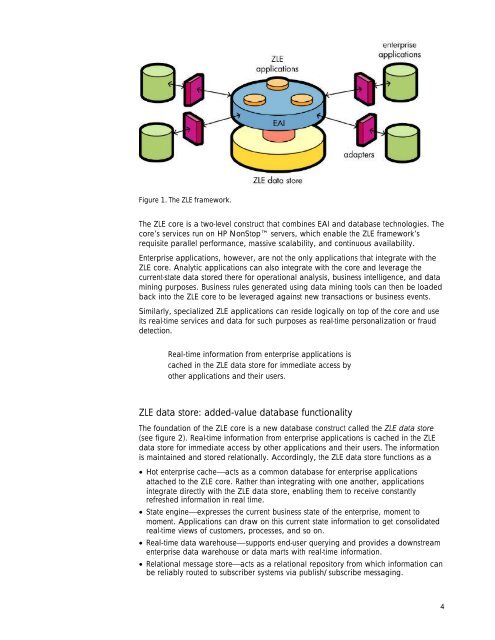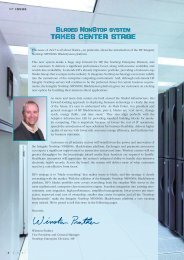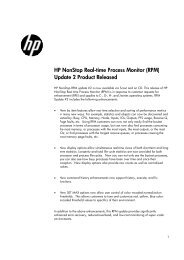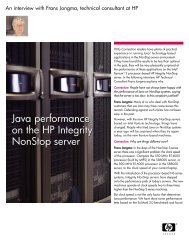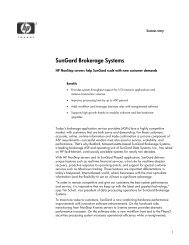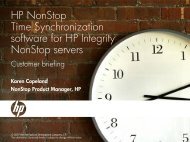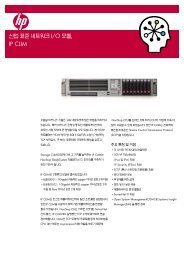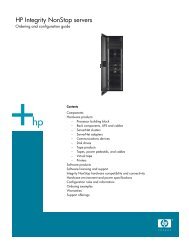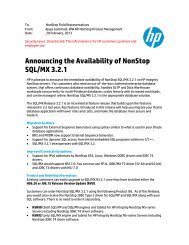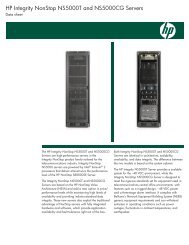the business case for a zero latency enterprise - HP NonStop
the business case for a zero latency enterprise - HP NonStop
the business case for a zero latency enterprise - HP NonStop
You also want an ePaper? Increase the reach of your titles
YUMPU automatically turns print PDFs into web optimized ePapers that Google loves.
Figure 1. The ZLE framework.The ZLE core is a two-level construct that combines EAI and database technologies. Thecore’s services run on <strong>HP</strong> <strong>NonStop</strong> servers, which enable <strong>the</strong> ZLE framework’srequisite parallel per<strong>for</strong>mance, massive scalability, and continuous availability.Enterprise applications, however, are not <strong>the</strong> only applications that integrate with <strong>the</strong>ZLE core. Analytic applications can also integrate with <strong>the</strong> core and leverage <strong>the</strong>current-state data stored <strong>the</strong>re <strong>for</strong> operational analysis, <strong>business</strong> intelligence, and datamining purposes. Business rules generated using data mining tools can <strong>the</strong>n be loadedback into <strong>the</strong> ZLE core to be leveraged against new transactions or <strong>business</strong> events.Similarly, specialized ZLE applications can reside logically on top of <strong>the</strong> core and useits real-time services and data <strong>for</strong> such purposes as real-time personalization or frauddetection.Real-time in<strong>for</strong>mation from <strong>enterprise</strong> applications iscached in <strong>the</strong> ZLE data store <strong>for</strong> immediate access byo<strong>the</strong>r applications and <strong>the</strong>ir users.ZLE data store: added-value database functionalityThe foundation of <strong>the</strong> ZLE core is a new database construct called <strong>the</strong> ZLE data store(see figure 2). Real-time in<strong>for</strong>mation from <strong>enterprise</strong> applications is cached in <strong>the</strong> ZLEdata store <strong>for</strong> immediate access by o<strong>the</strong>r applications and <strong>the</strong>ir users. The in<strong>for</strong>mationis maintained and stored relationally. Accordingly, <strong>the</strong> ZLE data store functions as a• Hot <strong>enterprise</strong> cache⎯acts as a common database <strong>for</strong> <strong>enterprise</strong> applicationsattached to <strong>the</strong> ZLE core. Ra<strong>the</strong>r than integrating with one ano<strong>the</strong>r, applicationsintegrate directly with <strong>the</strong> ZLE data store, enabling <strong>the</strong>m to receive constantlyrefreshed in<strong>for</strong>mation in real time.• State engine⎯expresses <strong>the</strong> current <strong>business</strong> state of <strong>the</strong> <strong>enterprise</strong>, moment tomoment. Applications can draw on this current state in<strong>for</strong>mation to get consolidatedreal-time views of customers, processes, and so on.• Real-time data warehouse⎯supports end-user querying and provides a downstream<strong>enterprise</strong> data warehouse or data marts with real-time in<strong>for</strong>mation.• Relational message store⎯acts as a relational repository from which in<strong>for</strong>mation canbe reliably routed to subscriber systems via publish/subscribe messaging.4


